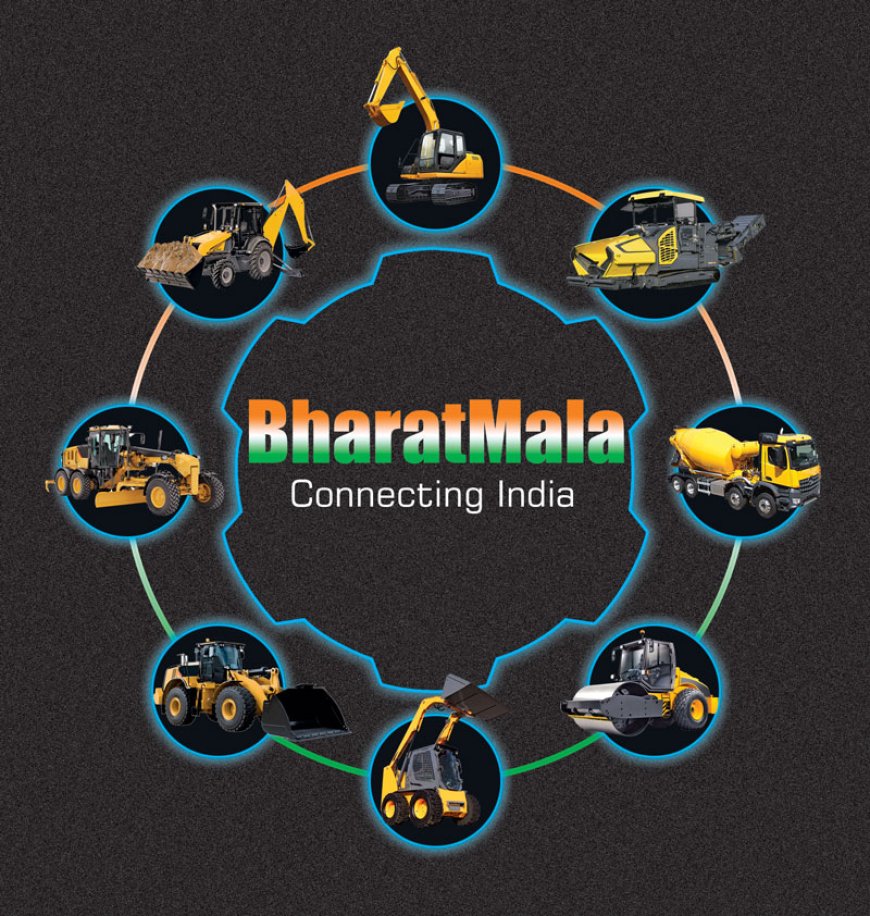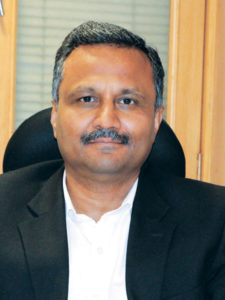BHARATMALA CONNECTING INDIA
The Bharatmala project has been touted as the second-largest highways construction project in India after the National Highways Development Project (NHDP). The road network built under the centre’s flagship Bharatmala project will assist in quicker movement of cargo and boost

The Bharatmala project has been touted as the second-largest highways construction project in India after the National Highways Development Project (NHDP). The road network built under the centre’s flagship Bharatmala project will assist in quicker movement of cargo and boost international trade, among other things. Equipment Times looks into the rising opportunities for OEMs, schemes further & accelerating the growth of the construction equipment sector, equipment employed in the project, challenges in the Bharatmala project.
India has about 62.16 lakh km of road network, which is the second largest in the world in terms of length. National Highways (NHs) constitute about 2% of the total road network, but carry about 40% of the total road traffic. The National Highways Development Project (NHDP) had reached a certain level of maturity. It was important to re-define road development and have a macro approach while planning expansion of the national highways network. Earlier, the rationale for highway construction was point to point connectivity; highways development was not planned with an economic perspective.
It was, therefore, required that the Origin and Destination of vehicular traffic, particularly of freight, be the basis of construction for the bigger i.e. 4-laning/6-laning National Highways (NHs). Hence it was proposed to launch a new umbrella program with the primary focus of optimizing the efficiency of the movement of goods and people across the country.
Key to Bharatmala program…
According to Ministry of Road Transport and Highways – Government of India, the umbrella program of Bharatmala focused on enhanced effectiveness of already built infrastructure, multi–modal integration, bridging infrastructure gaps for seamless movement and integrating National and Economic Corridors. The program was conceptualized to attain optimal resource allocation for a holistic highway development/improvement initiative.
At the time of conceptualization of Bharatmala Pariyojana, around 300 districts had NH connectivity. The bridging of critical infrastructure gaps in existing highway network would enhance safe and seamless movement of traffic, and in turn have a positive impact on the Logistic Performance Index (LPI) of the country.
To this effect, there are six key features of the program:
- Economic Corridors: Integrating the economic corridors facilitates larger connectedness between economically important production and consumption centers.
- Inter-corridor and Feeder routes: Inter-corridor connectivity would ensure first mile and last mile connectivity.
- National Corridor Efficiency Improvement: Through this, the greater actionable goal is to undertake lane expansion and decongestion of existing National Corridors.
- Border and International connectivity Roads: Better border road infrastructure would ensure greater maneuverability, while also boosting trade with neighboring countries.
- Coastal and Port connectivity roads: Port-led economic development is further boosted through connectivity to coastal areas, encouraging both, tourism and industrial development
- Green-field Expressways: Expressways have higher traffic configuration and choke points would benefit from green-field expressways.
Corridor Based Approach
The objective of the Bharatmala Pariyojana program is to optimize the efficiency of freight and passenger movement across the country by bridging critical infrastructure gaps through development of Economic Corridors, Inter Corridors and Feeder Routes, National Corridor Efficiency Improvement, Border and International connectivity roads, Coastal and Port connectivity roads and Green-field expressways. Identification of the project stretches under the components of the proposed program is based on detailed Origin-Destination (O-D) study, freight flow projections and verification of the identified infrastructure gaps through geo-mapping.
Construction of a total length of about 24,800 kms is being taken up under Phase-I of Bharatmala Pariyojana. In addition, Phase-I would also include about 10,000 kms of residual works of National Highway Development Project (NHDP).
Bharatmala Pariyojana was conceptualized as an umbrella program with a corridor-based approach:
- Origin-Destination study based on freight movement across 600 districts
- Technology-based automated traffic surveys over 1,500+ points
- Satellite mapping of corridors to identify upgradation requirements Decongestion of Highways
- 191 congestion points were identified across key cities on the National Highway corridor network
- Multiple interventions were identified for resolution of congestion points
– 29 ring roads addressing 44 Congestion Points
– 54 Bypasses addressing 56 Congestion Points
– 76 Lane Expansions & structures addressing 91 Congestion Points
Resolution of Blackspots
Road safety audits were conducted for 32,971 km and an additional length of 40,000 km is targeted till FY24. Consequently, 5785 blackspots were identified for removal & rectification as a permanent measure to reduce road accidents.
India’s road infrastructure to be on par with USA by December 2024
On March 16, Minister of Road Transport and Highways Nitin Gadkari informed the Rajya Sabha that the Centre is laying a roadmap to upgrade and enhance the web of India’s road infrastructure to be as good as America’s. Noting that “expanding road infrastructure is not the only problem”, the minister said that there are other aspects such as “road engineering, automobile engineering, awareness among people, and education,” according to ANI. Gadkari made the assertion while replying to a question during Question Hour in the Upper House, and sought more efforts to create awareness among the public about road safety.
The Minister also informed about the steps being taken by the central government to reduce accidents on National Highways (NH) and also in widening the roads connecting to NHs. Every time, a spot where more than one accident occurs is marked as a black spot, which is then focussed upon to reduce the accidents. Every year in India, 1.5 lakh people get killed in road accidents, “the figure is as high as that of the people killed in war,” he said.
Notably, as stated by the Road and Transport Ministry, the development of roads in India is ongoing at an average of 37 km per day. According to the website of the Ministry of Road Transport and Highways, “The Ministry has constructed 8,045 Km of National Highways up to February in 2021-22 as compared to 11,143 km constructed up to February in 2020-21. The award figure is 7,618 km during this period as compared to 8,512 Km in the previous year.”
National Corridors (NC)
National Corridors of India (NC) are 6 high volume corridors, including 4 in Golden Quadrilateral and 2 in North–South and East–West Corridors, including Mumbai – Kolkata Highway (NH6), known as East Coast – West Coast Corridor, that carry 35% of India’s freight. Lane expansion to 6 to 8 laning, ring roads, bypasses and elevated corridors will be built in Bharatmala to decongest the National Corridors. Logistics Parks will be set up along the NC. Busiest stretches of National Corridors will be converted to the expressways. 8,000 km (5,000 mi) inter-corridor and 7,500 km (4,700 mi) feeder routes will be built. Additionally, 3,300 km (2,100 mi) of border roads and 2,000 km (1,200 mi) international highways will be built to connect 6 National Corridors to international trade routes.
National Corridors Efficiency Program (NCEP)
National Corridors Efficiency Program (NCEP) entails 5,000 km (3,100 mi) phase-I decongestion of 185 choke points by 34 6-8 laning, 45 bypasses and 30 ring roads of 6 NC.
 Industry stakeholders uphold the project trends…
Industry stakeholders uphold the project trends…
Kritika Singh, Sr. Manager, Invest India, says, “The Bharatmala Pariyojana was thus launched in 2017, with an overarching corridor-approach, to optimise the efficiency of already built infrastructure, enable multimodal integration, bridge infrastructural gaps for a more seamless freight and passenger movement across the country and integrate National and Economic Corridors. Systemic interventions are being made under the Bharatmala Pariyojana, to achieve substantial improvements in the NH network with the completion of the program.”
 Vinay Kumar G, Assistant Vice President and Sector Head, Corporate Ratings, ICRA, states, “The objective of the programme is optimal resource allocation for a holistic highway development/improvement initiative to re-define road development and have a macro approach while planning expansion of the national highways network. To achieve this, national highways are categorised into national corridors, economic corridors and inter-corridors. Additional emphasis is also laid on feeder routes to address first and last mile connectivity challenges.”
Vinay Kumar G, Assistant Vice President and Sector Head, Corporate Ratings, ICRA, states, “The objective of the programme is optimal resource allocation for a holistic highway development/improvement initiative to re-define road development and have a macro approach while planning expansion of the national highways network. To achieve this, national highways are categorised into national corridors, economic corridors and inter-corridors. Additional emphasis is also laid on feeder routes to address first and last mile connectivity challenges.”
 Vivek Hajela, VP, CEB, Larsen & Toubro, said, “Our customers have employed a large number of machines from Komatsu and L&T at various locations for road and infrastructure projects undertaken by the Government under various schemes and projects. We offer a wide range to Komatsu’s excavators to our esteemed customers and have supplied large volumes of PC71, PC130, PC210-10M0 and PC300-8/PC350-8 excavator models for road construction. Komatsu PC210-10M0 Hydraulic Excavator, launched at the last EXCON held in Nov’2019, has been received exceptionally well. It has set new performance benchmarks and is set to become a game-changer for the industry. We have already sold 2000 machines, and many of them have clocked 10,000 hours of satisfactory performance. Therefore, we see this machine emerge soon as an undisputed leader in the 21-ton segment.”
Vivek Hajela, VP, CEB, Larsen & Toubro, said, “Our customers have employed a large number of machines from Komatsu and L&T at various locations for road and infrastructure projects undertaken by the Government under various schemes and projects. We offer a wide range to Komatsu’s excavators to our esteemed customers and have supplied large volumes of PC71, PC130, PC210-10M0 and PC300-8/PC350-8 excavator models for road construction. Komatsu PC210-10M0 Hydraulic Excavator, launched at the last EXCON held in Nov’2019, has been received exceptionally well. It has set new performance benchmarks and is set to become a game-changer for the industry. We have already sold 2000 machines, and many of them have clocked 10,000 hours of satisfactory performance. Therefore, we see this machine emerge soon as an undisputed leader in the 21-ton segment.”
 Rahul Shorey, National Head, Construction, Tata Hitachi Construction Machinery Company, said “Our equipment used in the Bharatmala project includes our wide range of technologically advanced excavators, backhoe loaders and wheel loaders. Our EX Super+ Series and ZAXIS GI Series of excavators have been deployed, which come loaded with features like online access to location of equipment, online health monitoring system, among several other parameters, apart from numerous other improvements. Hitachi Construction Machinery (HCM) has been a pioneer in developing hydraulic technology used in excavators, which includes the technologically superior HIOS III system that the ZAXIS GI Series are equipped with. These use regenerative hydraulics that reutilizes the returning pressurized flow through a regenerative circuit and channelizes this to areas with high demand of oil. This improves the productivity of the machines without incurring additional fuel expenses. Our backhoe loaders under the Shinrai brand and state-of-the-art wheel loaders are also being utilised in these projects. Added to this mix is our suite of telematics solutions, ConSite and InSite, a next generation service solution that harnesses the power of Information Communication Technology to deliver monthly reports to customers, provide summary reports that give an overview of the operation of all the fleet owner’s machines, and detailed reports on information about individual machines. In addition, through its remote fleet management system, ConSite allows the customer easy access to real time operating information to increase machine productivity and reduce downtime.
Rahul Shorey, National Head, Construction, Tata Hitachi Construction Machinery Company, said “Our equipment used in the Bharatmala project includes our wide range of technologically advanced excavators, backhoe loaders and wheel loaders. Our EX Super+ Series and ZAXIS GI Series of excavators have been deployed, which come loaded with features like online access to location of equipment, online health monitoring system, among several other parameters, apart from numerous other improvements. Hitachi Construction Machinery (HCM) has been a pioneer in developing hydraulic technology used in excavators, which includes the technologically superior HIOS III system that the ZAXIS GI Series are equipped with. These use regenerative hydraulics that reutilizes the returning pressurized flow through a regenerative circuit and channelizes this to areas with high demand of oil. This improves the productivity of the machines without incurring additional fuel expenses. Our backhoe loaders under the Shinrai brand and state-of-the-art wheel loaders are also being utilised in these projects. Added to this mix is our suite of telematics solutions, ConSite and InSite, a next generation service solution that harnesses the power of Information Communication Technology to deliver monthly reports to customers, provide summary reports that give an overview of the operation of all the fleet owner’s machines, and detailed reports on information about individual machines. In addition, through its remote fleet management system, ConSite allows the customer easy access to real time operating information to increase machine productivity and reduce downtime.
 V. G. Sakthikumar, Managing Director, Schwing Stetter India, said, “The National Infrastructure Pipeline is a enviable initiative by the government with a outlay of $1.3 Trillion, exclusively for the infrastructure development. The Bharatmala is a one of the biggest investment under the NIP and is again reinforced by the GATI SHAKTHI project under which the government aims to build a robust high speed road network across the country. The project focuses on optimizing efficiency of freight and passenger movement across the country. This project means a lot to the OEMs of the CE industry as it offers tremendous opportunity to supply equipment such as Batching Plants, Boom Pumps, Motor graders, Excavators and Truck Mixers and other road construction equipment.”
V. G. Sakthikumar, Managing Director, Schwing Stetter India, said, “The National Infrastructure Pipeline is a enviable initiative by the government with a outlay of $1.3 Trillion, exclusively for the infrastructure development. The Bharatmala is a one of the biggest investment under the NIP and is again reinforced by the GATI SHAKTHI project under which the government aims to build a robust high speed road network across the country. The project focuses on optimizing efficiency of freight and passenger movement across the country. This project means a lot to the OEMs of the CE industry as it offers tremendous opportunity to supply equipment such as Batching Plants, Boom Pumps, Motor graders, Excavators and Truck Mixers and other road construction equipment.”
 Speaking about perceiving the opportunities getting better for the OEMs in the construction equipment industry as the Bharatmala project aims to ensure speeding up approval processes to enable quicker execution of projects, Viraj Parthi, Sales Director, Terex Finlay, said, “The opportunities and demand are already showing improvement on account of Bharatmala project as these projects are only for 18-24 months timeline. There are a few months when the demand slows down due to various reasons like pandemic, rainy season, liquidity issues, etc. but overall the demand is encouraging.”
Speaking about perceiving the opportunities getting better for the OEMs in the construction equipment industry as the Bharatmala project aims to ensure speeding up approval processes to enable quicker execution of projects, Viraj Parthi, Sales Director, Terex Finlay, said, “The opportunities and demand are already showing improvement on account of Bharatmala project as these projects are only for 18-24 months timeline. There are a few months when the demand slows down due to various reasons like pandemic, rainy season, liquidity issues, etc. but overall the demand is encouraging.”
Talking about the equipment which are employed in the Bharatmala project and major contributions in this project, Parthi said, “We have launched hybrid crushers under our Finlay brand and are working under many projects in Bharatmala. These crushers are highly fuel efficient and have very low maintenance. It will not only save the operational costs but also gives higher availability of plants. The customers are very appreciative of these products and are going for repeat orders.”
When asked about the mile connectivity as a crucial element and how do you assess the challenges in the Bharatmala project in terms of construction equipment, Parthi said, “We are providing many innovative solutions for the last mile connectivity for these projects. We are helping in dismantling the equipment and assembling it at sites where the transportation is an issue for heavy equipment. We are also providing telemetry and service manpower at remote sites. We are also providing training to customers for the maintenance as well as trained manpower to operate the plants from these remote locations.”
 Vishwesh Rai, General Manager, Dynapac Road Construction Equipment, said, “In Bharatmala Project, we have supplied our full fleet of road construction equipment like soil compactors, Tandem Rollers, and Pavers working indifferent states in Rajasthan, Maharashtra, Andhra Pradesh, Gujarat and many more. Recently our machines are employed in Raipur- Vizag stretch. We as a Dynapac always think about the customers and are ready to be ‘Your Partner on the Road Ahead’. We are making our every effort to fulfill the vision of the government and supporting our customers in accomplishing this mission of Bharatmala project before the project completion time. I would like to give one example of Ahmedabad Airport repair and maintenance Project which was executed by Adani Group through Asphalt India Corporation Private Limited crew where contractor laid more than 4000 tonnes of Asphalt in runway in 9 hrs with Dynapac pavers at work. This was one of the record in asphalt paving of any airport project in India.”
Vishwesh Rai, General Manager, Dynapac Road Construction Equipment, said, “In Bharatmala Project, we have supplied our full fleet of road construction equipment like soil compactors, Tandem Rollers, and Pavers working indifferent states in Rajasthan, Maharashtra, Andhra Pradesh, Gujarat and many more. Recently our machines are employed in Raipur- Vizag stretch. We as a Dynapac always think about the customers and are ready to be ‘Your Partner on the Road Ahead’. We are making our every effort to fulfill the vision of the government and supporting our customers in accomplishing this mission of Bharatmala project before the project completion time. I would like to give one example of Ahmedabad Airport repair and maintenance Project which was executed by Adani Group through Asphalt India Corporation Private Limited crew where contractor laid more than 4000 tonnes of Asphalt in runway in 9 hrs with Dynapac pavers at work. This was one of the record in asphalt paving of any airport project in India.”
 Debasis Bhattacharya, Head, Sales & Marketing, Ajax Engineering, “We at AJAX feel honoured to be associated with such prestigious projects with our Next-Gen 360° concreting solutions. Our Batching Plants with modular design, quick set-up time, in-house manufactured planetary & twin shaft mixers, is the ideal choice of contractors for all their concrete production needs. And our boom pump with lower owning and operating cost ensuresour customers get value for their investment on our product. Going forward, we will also be having our Self-propelled Boom Pumps and Slipform Pavers deployed in such projects to address tough placement and pavement needs. Ajax offers state-of-the-art concreting machines equipped with top-class technology, adaptable to suit Indian conditions, thereby optimising productivity and ensuring reliability. We have 50+ member strong Design and engineering team, to not only bring in the latest technological features in our existing products but also indigenously design new products to address product / solution gaps in the market and import substitution.
Debasis Bhattacharya, Head, Sales & Marketing, Ajax Engineering, “We at AJAX feel honoured to be associated with such prestigious projects with our Next-Gen 360° concreting solutions. Our Batching Plants with modular design, quick set-up time, in-house manufactured planetary & twin shaft mixers, is the ideal choice of contractors for all their concrete production needs. And our boom pump with lower owning and operating cost ensuresour customers get value for their investment on our product. Going forward, we will also be having our Self-propelled Boom Pumps and Slipform Pavers deployed in such projects to address tough placement and pavement needs. Ajax offers state-of-the-art concreting machines equipped with top-class technology, adaptable to suit Indian conditions, thereby optimising productivity and ensuring reliability. We have 50+ member strong Design and engineering team, to not only bring in the latest technological features in our existing products but also indigenously design new products to address product / solution gaps in the market and import substitution.
We feel honoured to state that we are the only manufacturers of Self-loading Concrete Mixers who offer Load Cell based weigh batching system that confirms to IS 4925 standards, thanks to our investment on cutting edge technology.”
 Paresh Patel, Director, Global Sales, Alltech Industries India, said, “The Government announcement of Bharatmala Pariyojana is the second biggest highway development programme. Bharatmala Pariyojana is different from other existing projects as it focuses on improving the average speed of the road and by shortening the length of the roads and removing the congestions in existing network, which would help in reducing logistics costs. The development of any nation depends on the transportation networks and the way in which they are maintained. For connecting the areas and maintaining smooth flow of traffic, the construction of new and developed roads are a must. So, with the successful implementation of this Bharatmala project the Original Equipment Manufacturers of Asphalt Batch Mix Plant, Bitumen Decanting Equipment, Counter Flow Drum Mix Plant and Micro Surfacing Machine of this Road Construction equipment will definitely develop. Due to this Bharatmala project equipment Companies would see boost in the Growth.”
Paresh Patel, Director, Global Sales, Alltech Industries India, said, “The Government announcement of Bharatmala Pariyojana is the second biggest highway development programme. Bharatmala Pariyojana is different from other existing projects as it focuses on improving the average speed of the road and by shortening the length of the roads and removing the congestions in existing network, which would help in reducing logistics costs. The development of any nation depends on the transportation networks and the way in which they are maintained. For connecting the areas and maintaining smooth flow of traffic, the construction of new and developed roads are a must. So, with the successful implementation of this Bharatmala project the Original Equipment Manufacturers of Asphalt Batch Mix Plant, Bitumen Decanting Equipment, Counter Flow Drum Mix Plant and Micro Surfacing Machine of this Road Construction equipment will definitely develop. Due to this Bharatmala project equipment Companies would see boost in the Growth.”
 Sanjay Varma, Head, Plant and Machinery, NCC, said, “NCC has taken up and executed Road works in various states. We are using scientific planning and state of the art technology & equipment for achieving the targets. Latest and Higher Capacity Crusher, RMC Plants and Slip Form Pavers are deployed in the NMSCE Road Projects. Chilling Plants were used to supply water @ 5 Degree to RMC Plant to achieve concrete production, supply and laying of DLC/PQC as per MORTH Specifications.
Sanjay Varma, Head, Plant and Machinery, NCC, said, “NCC has taken up and executed Road works in various states. We are using scientific planning and state of the art technology & equipment for achieving the targets. Latest and Higher Capacity Crusher, RMC Plants and Slip Form Pavers are deployed in the NMSCE Road Projects. Chilling Plants were used to supply water @ 5 Degree to RMC Plant to achieve concrete production, supply and laying of DLC/PQC as per MORTH Specifications.
Precast Yard with System formwork and Gantries for executing Bridge’s I-Girders, Box Culverts and Boundary wall. NCC has initiated Digitalization of Plant & Equipment in Road Projects. Digital Initiatives have injected new dimension to our project functions through infallible mechanisms. Monitoring of All Mobile Equipments with GPS Tags and Fuel Sensors. Tracking of Equipment’s Fuel consumptions, Location, productivity, maintenance. Engine (Idle/Working) Utilizations and deviations, safety & security.”
 According to Harendra Singh, Chairman & Managing Director, H.G. Infra Engineering, “The infra-story of India has been dynamic. Bharatmala Pariyojana has been the thrust infra industry required. The BMP aims to fill the gaps in the infrastructure sector. The ambitious targets set for BMP by the government will lead to the development of the nation. Being the largest infrastructure program envisioned in 2017, Bharatmala aims to develop 34,800 km of National Highway corridors, connecting 600+ districts in the nation. The program signalled a paradigm shift to the corridor approach of infrastructure development. The award position of NHAI has improved significantly, which may positively impact the quicker execution of the project. Moreover, the Bharatmala Pariyojana (Phase II) is in the approval stage.”
According to Harendra Singh, Chairman & Managing Director, H.G. Infra Engineering, “The infra-story of India has been dynamic. Bharatmala Pariyojana has been the thrust infra industry required. The BMP aims to fill the gaps in the infrastructure sector. The ambitious targets set for BMP by the government will lead to the development of the nation. Being the largest infrastructure program envisioned in 2017, Bharatmala aims to develop 34,800 km of National Highway corridors, connecting 600+ districts in the nation. The program signalled a paradigm shift to the corridor approach of infrastructure development. The award position of NHAI has improved significantly, which may positively impact the quicker execution of the project. Moreover, the Bharatmala Pariyojana (Phase II) is in the approval stage.”
| Expressways/Corridors under Bharatmala Pariyojana Phase 1 | ||
| Project | Length (km) | Cost (Rs crore) |
| Delhi-Vadodara Expressway | 845 | 42,165 |
| Vadodara-Mumbai Expressway | 446 | 45,835 |
| Delhi-Faridabad-Sohna Expressway | 60 | 5,333 |
| Ahmedabad-Dholera Expressway | 109 | 4,192 |
| Delhi-Amritsar-Katra Expressway | 672 | 37,775 |
| Bengaluru-Chennai Expressway | 262 | 15,176 |
| Kanpur-Lucknow Expressway | 63 | 4,183 |
| Ambala-Kotputli Corridor | 313 | 11,375 |
| Chennai-Salem Corridor | 277 | 9,681 |
| Amritsar-Bhatinda-Jamnagar Corridor | 917 (of 1224) | 22,543 |
| Durg-Raipur-Arang Corridor | 92 | 2,689 |
| Raipur-Vishakhapatnam Corridor | 465 | 14,695 |
| Chitoor-Thatchur Corridor | 116 | 3,997 |
| Urban Extension Road II | 75 | 7,495 |
| Delhi-Dehradun Corridor | 210 | 10,294 |
| Bengaluru-Satellite Ring Road | 281 | 14,337 |
| Surat-Ahmednagar-Solapur | 641 | 28,212 |
| Solapur-Kurnool Corridor | 335 | 12,859 |
| Kharagpur-Siliguri (Till Morgram) | 235 | 5,671 |
| Indore-Hyderabad Corridor | 687 | 15,014 |
| Hyderabad (Suryapet)-Vishakhapatnam (Devarpalle) Corridor | 222 | 5,583 |
| Kota-Indore (Garoth-Ujjain) | 135 | 1,887 |
| Hyderabad-Raipur Corridor | 330 | 8,737 |
| Nagpur-Vijayawada Corridor | 405 | 14,666 |
Hits: 3








